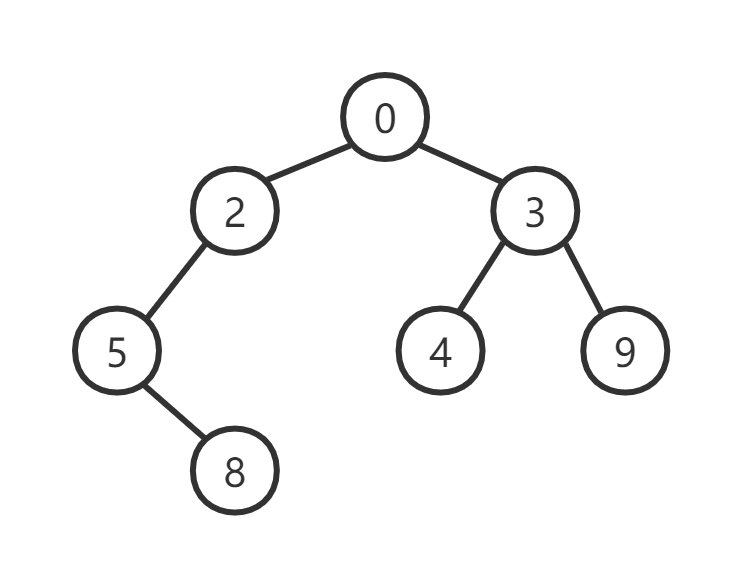【学习】java 二叉树(一)—— 基础认识
一、前言
这里主要是记录自己所学,所以一些基础概念就不再赘述(如二叉树、度、子树等的定义)。
二、构造与遍历
1. 构造
简单的二叉树主要是由值(value)、左子树(left)、右子树(right)构成,遇到具体问题时再此基础上增加属性。
public static class Node{
public int value;
public Node left;
public Node right;
public Node(int v){
value = v;
}
}
2. 遍历
为方便后续书写,这里先给出一棵二叉树作为例子。

二叉树总体而言有三种遍历方法,分别是:
- 先序遍历
- 根、左、右
- 0、2、5、8、3、4、9
- 中序遍历
- 左、根、右
- 5、8、2、0、4、3、9
- 后序遍历
- 8、5、2、4、9、3、0
用代码实现大体上有两种思路,分别是:递归遍历和非递归遍历
2.1 递归遍历
递归遍历顾名思义就是采用递归思想实现三种遍历方法。这里用中序遍历举例,对于树中的每个节点来说,都是做了同样的一件事——找其左、中、右节点(废话~),那么用递归代码实现就会非常简单。
// 中序遍历
public static void in(Node head){
if (head == null){
return;
}
in(head.left);
System.out.print(head.value);
in(head.right);
}
同理
//先序遍历
public static void pre(Node head){
if (head == null){
return;
}
System.out.print(head.value);
pre(head.left);
pre(head.right);
}
// 后序遍历
public static void pos(Node head){
if (head == null){
return;
}
pos(head.left);
pos(head.right);
System.out.print(head.value);
}
2.2 非递归遍历
相较于递归遍历三行代码就能实现先序中序后序,非递归遍历实现起来需要稍微麻烦一点。
非递归先序遍历
这里借助能够实现后进先出的栈结构,将当前节点的非空子节点依照先右后左的顺序入栈,然后pop节点,每次pop时做相同操作即可。由于栈顶元素一定是最新加入栈的节点,入栈顺序又是先右后左,故每次打印根节点后,都会优先遍历左节点,从而实现了先序遍历。
// 先序遍历
public static void pre(Node head){
System.out.println("先序遍历:");
if (head != null){
Stack<Node> stack = new Stack<Node>();
stack.push(head); // 根节点入栈
while (!stack.isEmpty()){
head = stack.pop(); // 出栈
System.out.print(head.value+" ");
if (head.right != null){
// 存在右节点,则入栈
stack.push(head.right);
}
if (head.left != null){
// 存在左节点,则入栈
stack.push(head.left);
}
}
}
System.out.println();
}
非递归后序遍历
非递归的后序遍历与先序相似,将入栈顺序从根、右、左改为根、左、右,并将出栈节点逆序打印即可。这是因为入栈顺序为根、左、右时,出栈顺序为根、右、左,那么逆序就会得到左、右、根。
// 后序遍历
public static void pos(Node head){
System.out.println("后序遍历:");
if (head != null){
Stack<Node> stack = new Stack<Node>();
Stack<Node> overeStack = new Stack<Node>();
stack.push(head); // 根节点入栈
while (!stack.isEmpty()){
head = stack.pop(); // 出栈
if (head.left != null){
// 存在左节点,则入栈
stack.push(head.left);
}
if (head.right != null){
// 存在右节点,则入栈
stack.push(head.right);
}
overeStack.push(head); // 存储出栈节点
}
while (!overeStack.isEmpty()){
// 逆序打印
System.out.print(overeStack.pop().value + " ");
}
}
System.out.println();
}
非递归中序遍历
还是要借助栈,由于中序遍历是左根右,那么依照递归序,先将所有左子树入栈,当左子树为空时,当前节点即可打印并出栈,之后再将右节点作为根节点重复上述步骤。
// 中序遍历
public static void in(Node head){
if (head != null){
System.out.println("中序遍历:");
Stack<Node> stack = new Stack<Node>();
while (!stack.isEmpty() || head != null){
if (head != null){
// 当head 不为空时,直接入栈,并遍历左子树
stack.push(head);
head = head.left;
}else {
// head为空,stack中存在节点,则出栈并遍历右子树
head = stack.pop();
System.out.print(head.value + " ");
head = head.right;
}
}
System.out.println();
}
}
实现的方法有很多,只要明白遍历的先后顺序就能轻而易举的实现。



